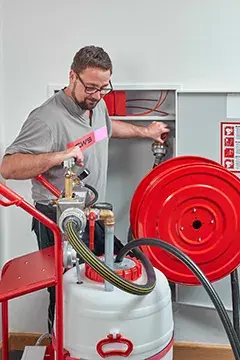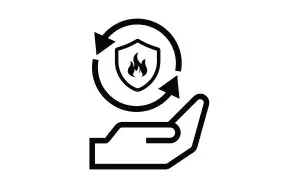Extinguishing water technology is a central component of preventive fire protection. This area includes, among other things, various hydrants as well as systems that ensure the supply of extinguishing water in case of fire. In addition, the hygienic separation of drinking and extinguishing water is essential.
CWS undertakes the planning, installation, maintenance and repair of all types of extinguishing water systems such as hydrants or extinguishing water transfer points.

Extinguishing water technology an overview
We offer a wide range of solutions in the field of extinguishing water technology. These include hydrants, drinking water separation stations, pressure boosting systems and various accessories & components.
Click on the various products and learn more.
Your advantages with CWS
Experienced & reliable
Our experts for extinguishing water technology have years of experience and provide you with expert advice.
Active nationwide
We are active throughout Germany and provide you with permanent regional contacts.
All-round service
Planning, installation and maintenance - CWS offers you holistic solutions for extinguishing water technology.
Partner of the trade
We provide support in planning and implementation for standard-compliant fulfilment of all requirements in the field of extinguishing water technology.
Planning and consulting service for extinguishing water technology

We provide support in meeting any specifications in the field of extinguishing water technology. In addition to expert advice and planning, this also includes the supply of components for all types of extinguishing water systems.
- Technical advice & individual planning
incl. special solutions, refurbishments & construction support
- Training & instruction
for optimal operation of your systems
- Commissioning & maintenance
by our expert service technicians
Maintenance and inspection of hydrants and water-based firefighting systems
Hydrants and other extinguishing water systems must be checked regularly by a competent person. The following maintenance intervals apply:
- Annual maintenance: wall, above-ground and underground hydrants, pressure boosting systems and filling and emptying stations.
- Maintenance every 2 years: "dry" extinguishing water systems
- Inspection every 3 - 6 years (depending on the federal state): Additional inspection by an expert in accordance with the inspection regulations of the federal states.
CWS undertakes the maintenance and repair of extinguishing water systems such as hydrants of any design or pressure boosting systems. Contact us for a non-binding offer.

FAQ - Extinguishing water technology
We provide answers to the most frequently asked questions about hydrants and other extinguishing water systems.
Why must drinking water be separated from extinguishing water?
An extinguishing water system is only used in case of fire. Consequently, extinguishing water often remains in the extinguishing water pipes for a long time and leads to the risk of dangerous bacteria forming. Thus, a separation of drinking water and extinguishing water is mandatory and required by standards or the Drinking Water Ordinance in order to avoid a backflow of possibly contaminated water.
Is an extinguishing water transfer point also necessary for existing buildings?
The use of approved extinguishing water transfer points is strongly recommended in order to implement extinguishing water systems in a technically flawless and legally compliant manner. CWS will be happy to support you in this.
Must I retrofit an extinguishing water system in existing buildings with a drinking water separation station?
As long as the system is functioning properly without any defects, the operator of the building is not obliged to do so. However, as soon as the system needs to be repaired, we strongly recommend retrofitting the drinking water separation station. This way, at the latest, the inspection expert would demand it when accepting the system.
How often is the maintenance of hydrants and other facilities in the area of extinguishing water technology required?
Hydrants of any design, pressure boosting systems or extinguishing water tanks as well as filling and emptying stations require annual maintenance by a competent person. In addition, extinguishing water systems must be inspected every three to six years (depending on the federal state) by a testing expert or an authorised expert. Furthermore, a two-year maintenance interval is prescribed for the "dry" extinguishing water system. In addition, there are defined operator obligations as well as special regulations for hydrants and other extinguishing water systems.
What is a hydrant?
A hydrant is used by the fire brigade to draw off extinguishing water in the event of a fire. There are the following types of hydrants:
- Underground hydrant
- Above-ground hydrant
- Wall hydrants
Fire hydrants are found in all towns and communities in Germany so that the fire brigade can quickly draw fire-fighting water from the public drinking water network.







